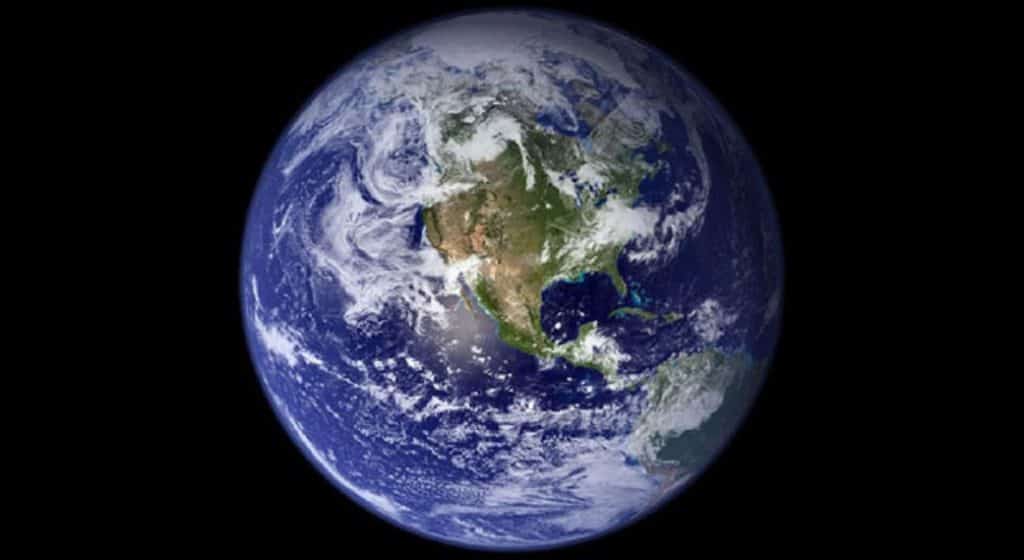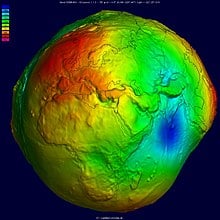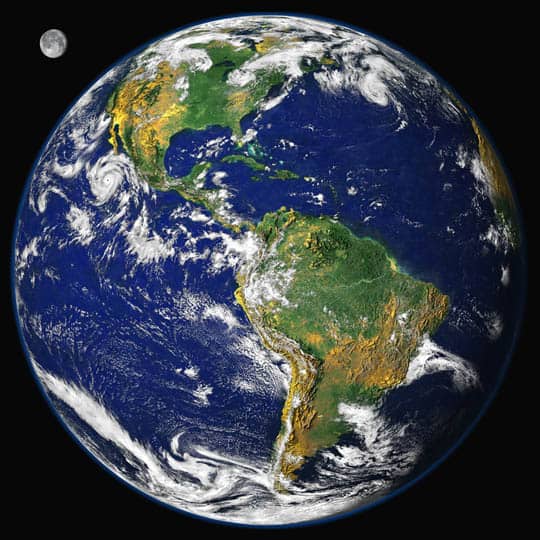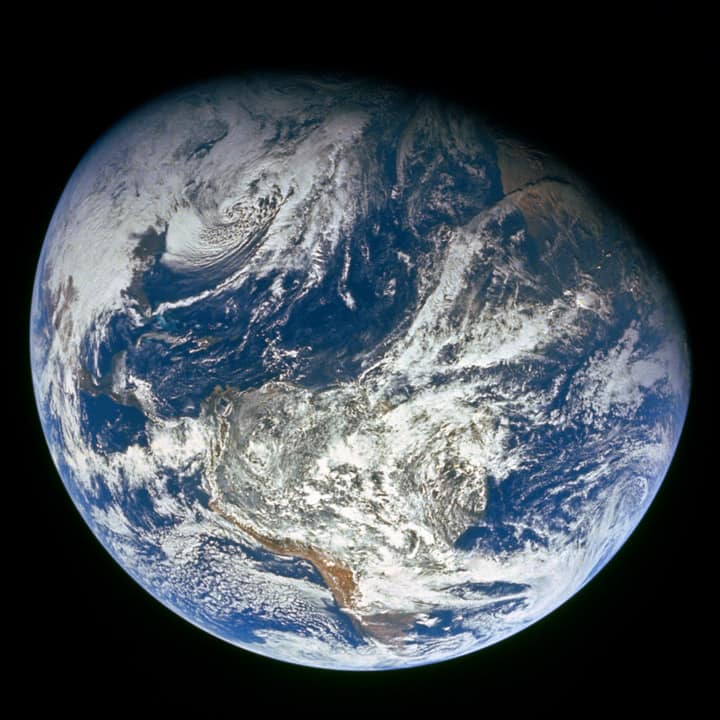Earth is the only planet whose English name does not derive from Greek or Roman mythology. The name of our planet comes from the Old English and Germanic languages. Many languages throughout the world have their own names for our planet.
Key Facts & Summary
- Earth is the third planet from the Sun and our home planet.
- Earth revolves around the Sun, but its average distance from it is 149 million kilometers / 93 million miles. In astronomy, this is 1 AU – or an astronomical unit.
- Scientists have researched and estimated that our Earth is around 4.5 billion years old.
- Earth formed at around the same time as the rest of our Solar System.
- Earth revolves around the Sun once every 365.25 days – this is known as one Earth year.
- In one year, Earth rotates like a spinning ball about 366.25 times – they are known as Earth days.
- Earth is the fifth largest planet of the Solar System. It has a diameter of 6.371 km / 3.958 mi. It is the largest terrestrial planet. The other terrestrial planets are Venus, Mars, and Mercury.
- The name Earth is at least 1.000 years old. It simply translates to “the ground”. The Greek name for Earth was Gaia – Mother Earth.
- Only 3% of Earth’s water is fresh and 97% of it is salty.
- The surface of Earth is covered by water, around 71%, only 29% of Earth’s surface is covered by land.
- The mixture of gases commonly known as air are nitrogen, oxygen, argon, and carbon dioxide. Without them, we couldn’t live.
- The atmosphere of Earth is divided into 6 layers – the troposphere, stratosphere, mesosphere, thermosphere, exosphere, and ionosphere.
- Earth has the greatest density out of all the planets in our Solar System. This means it is very compact.
- Earth has only one satellite – the Moon, but it also has a couple of temporal artificial satellites.
Earth is the third planet from the Sun and the fifth largest planet of the Solar System. It is currently the only known location where life is present.
Studying our Earth both with and without the aid of a spacecraft can help us understand just how life developed here and not someplace else.

It was not until the twentieth century that we had maps of the entire planet. Every picture taken from space of our world is very important since they help in predicting the weather, especially in tracking and predicting hurricanes.
Surface and Structure
The surface of the Earth is very young – this means that the surface changed a lot from when it was first formed. Erosion and tectonic processes, like earthquakes, for example, destroy, recreate, and reshape most of Earth’s surface.

Earth is currently the only known planet where water can exist in liquid form on the surface. Most of our planet is covered by water, around 71%. The vast oceans keep the temperatures on Earth stable, and this is crucial in the maintaining of life. Water is essential for life, at least the way we know it.
Water is also responsible for most of the erosion and weathering of the Earth’s continents, a process which is unique in our Solar System. Our Earth has four major main layers: an inner core at the center, an outer core enveloping it, the mantle, and the crust.
Time on Earth
One day on Earth, or the period in which the planet rotates once on its axis, is 23.9 hours. One Earth year or the period it takes for a celestial body to orbit the Sun once, takes about 365,25 days.
Because of these numbers, we add one day on our calendars every 4 years to maintain their consistency with the planet’s orbit. This is called a leap day.
Fun facts
- The continent of Asia covers about 30% of all the land. Around 60% of the world's population is located there.
- Earth has a core underground in its center. The temperatures there have been estimated to be at 9.800 Fahrenheit / 5.400 degrees Celsius – This is even hotter than the surface of the Sun.
- On average, one kilogram of Earth’s seawater contains 35 grams of salt.
- Our planet is traveling through space at roughly 107,826 kilometers / 67.000 miles per hour. Since we are so small, we do not feel this incredible speed.
- If all the people on Earth would jump at the same time, we could produce a magnitude 4 to 8 earthquake.
- The Sun is gigantic! More than 1.3 million Earth’s could fit inside the Sun.
- The first images of Earth taken from space happened on the 24th of October, 1946.
- The Moon is distancing itself from Earth about one inch every year.
- Earth, along with the Solar System, is situated in the Milky Way galaxy. Our Solar System orbits the center of the Milky Way at a distance of 28.000 light-years away.
- Light reaches us from the Sun in about 8 minutes. If the Sun would vanish, we wouldn’t know it until after 8 minutes.
Size and Comparison
Earth is the fifth largest planet in the Solar System. It has a diameter of 6.371 km / 3.958 mi. It is the largest terrestrial planet. In comparison, Mercury has about 38% of Earth’s diameter. As such, Earth is almost three times bigger.

When it comes to Venus, it has about 94% of Earth’s diameter. Mars, on the other hand, is only half the size of Earth. When it comes to the gas giants, things are a bit different.
Both Neptune and Uranus are four times bigger than Earth. Saturn is 9.5 times the Earth’s diameter while Jupiter has more than 11 times the Earth’s diameter. It would take around 1.300 Earth’s to fit Jupiter’s volume.
Trivia
Why is Earth a planet?
A celestial object is considered a planet if:
- It orbits the Sun – or any other star.
- It is massive enough to be rounded by its own gravity.
- It has cleared the neighborhood region of its own orbit of very small objects.
The scientific name for Earth
No scientific name has been given for Earth since it is the only planet of its type. Sometimes, the word “Globe” is often used to refer to Earth. Other times, the word “World” refers to Earth and all life that exists on it.
However, it is unknown who named our planet “Earth,” but its origin is the Anglo-Saxon word “erda” which means “soil.” It later became “eorthe” and then “erthe” in the Middle English. In the early 15th century, the word “Earth” was used for the first time as the name of our planet.
Earth isn’t completely spherical
Our Earth has an equatorial radius of 6.371 km / 3.958 mi and a polar radius of 6.356 km / 3.949 mi. This means that it isn’t completely spherical but a bit bulged at the equator due to rotation.

Other Characteristics
The atmosphere of Earth consists of 77% nitrogen, 21% oxygen, traces of argon, carbon monoxide, and water. The carbon dioxide is very important.

It helps to maintain Earth’s temperatures – Greenhouse Effect. This process warms Earth’s temperatures, and without it, the oceans would freeze and life as we know it would probably cease to exist.
Earth’s atmosphere also protects us from incoming meteoroids, most of them break up in the atmosphere before they reach the surface. Earth is the biggest of the terrestrial planets – Mars, Mercury, Venus.
Earth has only one natural satellite, the Moon. The Moon was used since ancient times to keep track of time. Earth’s Moon is the fifth largest of all the moons in the Solar System.
It is tidally locked to Earth, and thus it always shows us just one side of its surface. The Moon is also responsible for a steady climate here on Earth, it causes tides, creating a rhythm that has guided humanity for thousands of years.

Earth is truly unique among the planets of the Solar System. It is also very beautiful, with white clouds, blue oceans, and brown lands that shine against the black backdrop of our Solar System. We should try and keep it that way.
Earth Notes
- Earth is the densest major body in the Solar System – it is very compact.
- Our Earth is around 4.5 to 4.6 billion years old, but the oldest known rocks are less than 4 billion years old. The oldest fossils of living organisms are less than 3.9 billion years old.
- Earth is the third planet from the Sun, and the fifth largest out of all the planets of the Solar System.
- The continents of Earth move at the same rate as human fingernails grow.
- The Moon is the only natural satellite of Earth. It orbits around us roughly as fast as a rifle bullet.
Sources:
[1.] NASA
[2.] Wikipedia
Image sources:
- https://www.nasa.gov/centers/goddard/images/content/638831main_globe_east_2048.jpg
- https://www.nasa.gov/sites/default/files/styles/image_card_4x3_ratio/public/thumbnails/image/westernhemisphere_geos_2019246_lrg.jpg
- https://cdn.mos.cms.futurecdn.net/rCdTVsPesASiv3JeVyhHsa-1200-80.jpg
- https://eoimages.gsfc.nasa.gov/images/imagerecords/0/565/BlueMarble.jpg
- https://eoimages.gsfc.nasa.gov/images/imagerecords/36000/36019/AS8-16-2593.jpg
- https://upload.wikimedia.org/wikipedia/commons/thumb/4/4a/Geoid_undulation_10k_scale.jpg/220px-Geoid_undulation_10k_scale.jpg
